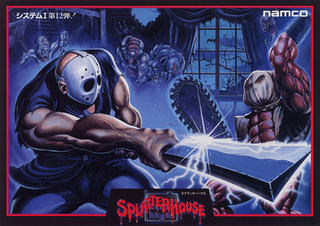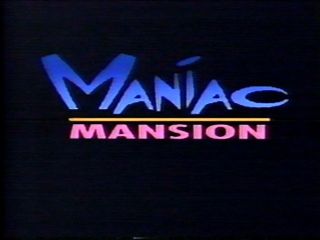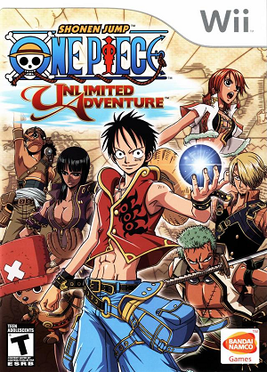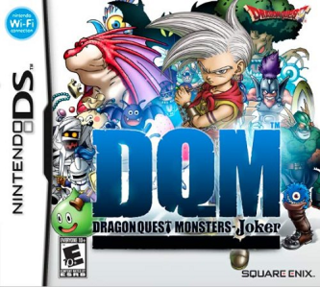In video games, a power-up is an object that adds temporary benefits or extra abilities to the player character as a game mechanic. This is in contrast to an item, which may or may not have a permanent benefit that can be used at any time chosen by the player. Although often collected directly through touch, power-ups can sometimes only be gained by collecting several related items, such as the floating letters of the word 'EXTEND' in Bubble Bobble. Well known examples of power-ups that have entered popular culture include the power pellets from Pac-Man and the Super Mushroom from Super Mario Bros., which ranked first in UGO Networks' Top 11 Video Game Powerups.

Mew is one of the many fictional species in the Pokémon franchise. It is a small, pink, Psychic-type Mythical Pokémon, which are incredibly rare and powerful Pokémon typically available only via special events. It was added to Pokémon Red and Blue by Game Freak programmer Shigeki Morimoto at the tail end of the games' development. Though it was not planned to be obtainable, after it was discovered through data mining, its presence in the games was surrounded by many rumors and myths. For years, Mew could not be obtained legitimately in the games except through some specific Pokémon distribution events, though it could be obtained through a variety of glitches.

The Adventures of Willy Beamish is a graphic adventure game developed by Dynamix and published in 1991 by Sierra On-Line. The player takes on the role of the eponymous youngster in a game that somewhat parodies the adventure genre. The game pioneered the use of in-game graphics drawn to resemble classic hand-drawn cartoon animation. It was initially released for MS-DOS and the Amiga and was ported to the Sega CD in 1993. CD versions of the game complemented the in-game text with speech, and included a few other cosmetic changes. A sequel was reportedly planned starring Willy Beamish as a late teenager, but the project was canceled.

Mon Colle Knights, known in Japan as Six Gates Far Away Mon Colle Knight, is a Japanese manga series written by Satoru Akahori and Katsumi Hasegawa and illustrated by Hideaki Nishikawa. The original concept was made by Hitoshi Yasuda and Group SNE. The series is based on the Monster Collection trading card game.

Rampage is a 1986 arcade video game by Bally Midway. Inspired by monster films, players control a trio of monsters: George, Lizzie, and Ralph, humans transformed into creatures due to various experimental mishaps. The objective is to destroy cities and combat military forces while maintaining their health. The game is set across 128 days in cities throughout North America, with each cycle repeating five times. Gameplay includes destroying buildings, eating humans, and avoiding damage.

Final Doom is a first-person shooter video game developed by TeamTNT, and Dario and Milo Casali, and was released by id Software and distributed by GT Interactive in 1996. It was released for MS-DOS and Macintosh computers, as well as for the PlayStation, although the latter featured a selection of levels from the game and from Master Levels for Doom II.

Deadly Rooms of Death (DROD) is a puzzle video game created by Erik Hermansen in 1996. The original version of the game was published by Webfoot Technologies. In 2000 the author reacquired the rights from Webfoot and released the source code; he continues the support and development as Caravel DROD.

Wonder Boy III: The Dragon's Trap, known as Monster World II in Japan, is a platforming action-adventure video game developed by Westone as part of Sega's Wonder Boy series. It was published by Sega and released for the Master System in 1989 and for the Game Gear in 1992 as Wonder Boy: The Dragon's Trap. It was ported by Hudson Soft and released in 1991 for the TurboGrafx-16/PC Engine under the name Dragon's Curse. It was also ported in 1993 by Brazilian company Tec Toy under the title Turma da Mônica em o Resgate, with the game retooled to include characters from Brazilian comic book series Monica's Gang. A remake developed by Lizardcube and published by DotEmu, titled Wonder Boy: The Dragon's Trap, was released in April 2017.

Samson & Goliath, also known as Young Samson, is an American animated television series produced by Hanna-Barbera Productions for NBC, where it debuted on September 9, 1967. Primarily sponsored by General Mills, who controlled the distribution rights through its agency Dancer Fitzgerald Sample, Samson & Goliath was retitled Young Samson in April 1968 to avoid confusion with the stop-motion Christian television series Davey and Goliath.

Splatterhouse is a beat 'em up arcade game developed and published by Namco in 1988. It was the first in a series of games released in home console and personal computer formats. This game would later spawn the parody Splatterhouse: Wanpaku Graffiti, the sequels Splatterhouse 2, Splatterhouse 3, and the 2010 remake Splatterhouse, with the classic games being added to Namco Museum since 2017.

Freddi Fish 5: The Case of the Creature of Coral Cove is a 2001 video game and the fifth and final game in the Freddi Fish series of adventure games. It was developed by Humongous Entertainment and published by Infogrames.

Maniac Mansion is a sitcom which aired concurrently on YTV in Canada and The Family Channel in the United States for three seasons from September 14, 1990, to April 4, 1993.

Pepper's Adventures in Time is an educational adventure game released in 1993 by Sierra On-Line. The project was based on a concept by Sierra VP of Development/Creative Director, Bill Davis, who also designed the game's main characters. This was intended to be the first in a series of edutainment games in which the player, as Pepper, traveled back in time to set right mixed-up situations surrounding famous individuals.

One Piece: Unlimited Adventure is a video game for the Nintendo Wii based on the manga and anime series One Piece by Eiichiro Oda, released in Japan on April 26, 2007 and in North America on January 22, 2008. The NTSC (American) version of the game uses the FUNimation voice actors exclusively.

Dragon Quest Monsters: Joker is a 2006 role-playing video game developed by Tose and published by Square Enix for the Nintendo DS. It is the fourth installment of the Dragon Quest Monsters series. This was the first game in the series to have online play, done using Nintendo Wi-Fi. A sequel, Dragon Quest Monsters: Joker 2, was released in 2010.

The Mask: Animated Series is an American animated television series based on the 1994 film of the same title. The series aired for a total of three seasons and fifty-four episodes from August 12, 1995, to August 30, 1997. It spawned its own short-run comic book series, Adventures of The Mask. John Arcudi, former writer of the original comics, wrote two episodes of the series. The Mask was one of three animated series based on Jim Carrey movies that premiered the same year. These included the 1995–2000 Ace Ventura: Pet Detective series, and the 1995–1996 Dumb and Dumber series.
Monster by Mistake is a Canadian animated television series that aired on YTV from September 18, 1999 to March 23, 2003 after airing its pilot on October 26, 1996. The series was created by Mark Mayerson of Catapult Productions, and co-produced with CCI Entertainment in Toronto, Canada. The two companies partnered in Studio 345, a computer animation and former Sears catalogue production facility for the production of the show, which was made using Houdini software. It was one of the earliest TV shows to be entirely computer-animated. The series also aired on Disney Channel in the UK.

Future-Worm! is an American comic science fiction animated television series created by Ryan Quincy, who previously created IFC's Out There, for Disney XD. The show features the adventures of Danny and Future-Worm, who time travel by using a lunch box-shaped time machine.















